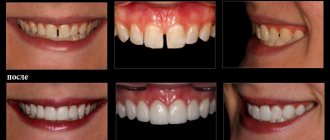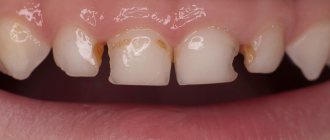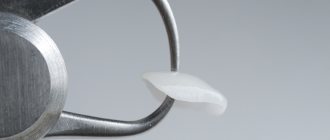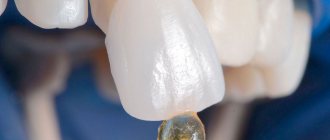What is a gap from a dental point of view?
In dentists' language, the gap between teeth is called diastema (from Greek - “gap, distance”). According to statistics, varying degrees of this defect are present in every fifth adult on the planet. In childhood, increased interdental space is often temporary; it is observed in 50% of preschool children. Diastema refers to an abnormally large empty space between the incisors (can reach 10 mm).
Patients often confuse a diastema (a gap between “units”) with a trema (a gap between any teeth in a row), although formally these are completely different defects, although similar in essence. Accordingly, the approach to treatment/elimination is different in both cases.
Why correct an overbite?
While some people, together with an orthodontist, are selecting the best way to correct their bite, others are wondering - why is this necessary?
There is a myth that malocclusion and crooked teeth are purely aesthetic issues. And if a person is not bothered by his appearance, there is no point in fixing his teeth. Orthodontists have a different opinion on this matter.
Even those malocclusions that do not bother the patient lead to certain health problems:
- An incorrect bite may be accompanied by abrasion of tooth enamel and exposure of the tooth root as a result of the load being distributed incorrectly when chewing.
- When the functioning of the temporomandibular joint is impaired, a person is often bothered by headaches.
- With severe malocclusion, speech and diction are impaired.
- Incorrect position of teeth interferes with normal hygiene. Even a good toothbrush, floss, or irrigator cannot thoroughly clean hard-to-reach areas, which leads to the development of caries and other dental diseases.
- In patients with malocclusions, it is not uncommon to have diseases of the digestive tract, since the position of the teeth interferes with chewing function.
- The abnormal shape and position of the jaw can affect changes in the skeletal system as a whole and contribute to diseases of the respiratory and musculoskeletal systems of the body.
The connection between malocclusion and health is obvious, so it is important to think about how to correct your teeth. This issue is best addressed in childhood and adolescence, although modern dental technologies help correct malocclusion with braces or other methods in adulthood.
Reasons for the appearance and enlargement of gaps between teeth
The gap between the front teeth is a result of internal or external factors. Most often it occurs as a result of:
The cause may also be the presence of microdentia, which inherently affects the symmetry of the teeth.
An increase in an existing gap occurs for the following reasons:
- abuse of chewing seeds;
- progressive problems with the root system;
- the appearance/development of various types of orthodontic pathologies;
- Frequent chewing of hard food (particularly with the front teeth).
Correct and recommended prevention will help maintain the diastema at the existing level (prevent the distance between the incisors from becoming larger), and the orthodontist will select an individual program for eliminating the defect.
Conclusions. Expert advice
Crooked teeth can appear for various reasons, ranging from heredity to bad habits. Both primary and permanent elements of the dentition grow incorrectly, and the “eights” of wisdom are almost always not formed correctly enough. Tooth curvature is not only a childhood disease. Trauma, age-related changes, or even a love of chewing pencils can cause problem teeth in adults.
It doesn’t matter whether you have one or several crooked incisors, you definitely need treatment. The first thing you need to do is contact a therapist, and then an orthodontist, who will decide what to do with crooked teeth in your situation. There are quite a few treatment methods, each with its own pros and cons. Sometimes the doctor decides to combine several methods, for example, installing braces and prescribing wearing a trainer. In especially severe cases, surgery is used.
Lack of treatment is very dangerous, because when teeth are crooked, the load during chewing is distributed unevenly. The longer the patient waits, the more severely some elements of the dentition wear out, leaving others without work. This leads to premature loss of molars and incisors. This is followed by bone depletion and expensive implant surgery, if it is possible at all. Avoiding such a development of events is not so difficult: you need to visit the orthodontist in time and correct the bite.
Types of diastemas
How the gap between the teeth can be removed depends on the reasons why the gap appeared. Therefore, it is very important to correctly identify the species. Diastemas are classified according to three main characteristics:
- By time of occurrence of the defect
:- False
. It is diagnosed in children when the bite is not yet fully formed. The problem disappears on its own without third-party intervention after replacing baby teeth with permanent ones. - True. Diagnosed in adolescents and adults in the period after the formation of the bite. It occurs due to periodontal pathologies, injuries or the absence of some frontal teeth in a row.
- By location
:- Symmetrical
. The location is determined relative to the conditional center of the dentition (usually oriented along the frenulum). The position of the incisors relative to each other is also taken into account. - Asymmetrical
. Most often, one of the incisors is in its place, and the second is deviated relative to the conditional center. - According to the position of roots and teeth
:- Literal deviation of crowns
. The defect is most often observed in people with a superset of teeth. In this case, the position of the roots is correct, but the incisors themselves deviate. Usually the gap in this case is no more than two millimeters. - Hull literal offset
. A common cause of the defect is excessively compacted bone tissue of the middle suture, which does not allow teeth to erupt in the place where they are needed. It is expressed in the lateral displacement of both the root and the incisor. - Medial tilt
. The most complex defect that can occur with the central incisors. As in the previous case, teeth and roots shift, but they can grow not only to the sides, but also with a displacement around their own axis.
To understand how to remove the gap between the front teeth and which method is best to choose, the dentist must correctly determine the type of diastema. Keep in mind that it is impossible to get rid of a gap on your own or at home - you cannot do this without the help of a specialized doctor.
When is dental restoration required?
Indications:
- Presence of caries.
- Aesthetic defects of the dentition: chips, cracks, darkening.
- Old fillings that are noticeable and stand out when you smile.
- Presence of large interdental spaces.
- Non-carious lesions: fluorosis, enamel hypoplasia, enamel necrosis and others.
- Minor crooked teeth that can be corrected without installing braces.
How can a gap be dangerous?
A small gap between the teeth can be a highlight and be regarded solely as an aesthetic defect. This problem does not bother some people, even those who are often under the gun of video cameras (for example, E. Temnikova, Madonna, K. Novikova, V. Paradis, K. Raikin, etc.). However, in some cases, diastema can cause serious functional disorders. Without therapeutic intervention, the size of the gap will increase, which has the following consequences:
- speech defects (their degree depends on the size of the diastema);
- violation/change in bite (due to uneven chewing load on the upper and lower jaw);
- caries (pathogenic bacteria and hard deposits accumulate in the interdental space; regular home cleaning is not always enough to combat them);
- inflammation and other gum diseases (due to direct contact of the gums with chewed food).
An experienced orthodontist can determine exactly how to remove the gap between the front teeth and whether it is necessary for medical reasons. If the defect is purely aesthetic, then only you can decide whether it needs to be eliminated.
What could be the consequences?
It is impossible to ignore an incorrect bite: the consequences turn out to be much deeper than just crooked teeth in the photo and inconvenience when chewing. Crooked teeth are difficult to clean, so bacteria accumulate among them, causing chronic inflammation. It can spread to the mucous membrane and even to the bone. Another disease of this kind is chronic stomatitis. It appears due to the fact that the tooth constantly damages the mucous membrane in one place.
An incorrect bite leads to poor digestion of food, which can lead to gastritis or even an ulcer. This is also facilitated by the entry of bacteria into the intestinal tract. Along with gastrointestinal diseases, skin diseases appear, hair becomes more brittle, and other organs that do not receive sufficient nutrition also suffer.
The uneven position of teeth also provokes premature aging of the facial skin and the appearance of deep expression wrinkles. And too much stress on the masticatory muscle is transferred to the joint, which quickly wears out, begins to click, crunch, and then hurt. Unpleasant sensations almost always go to your head, causing something like a migraine.
How to remove a gap between teeth
The main task that a dentist faces when solving the problem of diastema is to achieve the most even alignment of the central incisors. Depending on the chosen method, this process may take 2-3 dental procedures or last several years (the duration of treatment depends on the complexity and causes of the problem, the age of the patient and other factors).
Modern dentistry offers as many as 10 progressive methods of combating the gap between the front teeth:
- Surgical plastic surgery.
- Bracket systems.
- Records.
- Veneers.
- Lumineers.
- Cosmetic correction.
- Artistic restoration.
- Crowns.
- Implants.
- Mouthguards.
It would not be superfluous to study in detail the features of each technique, comparing their effectiveness and other characteristics.
Surgical plastic surgery
This method is used in the case of a congenital defect associated with an incorrect position of the labial frenulum (it is because of this that the incisors cannot close correctly). Surgical plastic surgery of the frenulum will not remove the gap, but will create conditions under which the teeth will be able to take the correct position. And after this, the dentist selects an effective method of correction. This technique has several nuances related to the patient’s age:
- This procedure is most effective for children 5-8 years old - after the operation, the incisors will close on their own without additional dental intervention.
- After surgery, older patients will be forced to wear orthopedic structures (some of which are fixed not temporarily, but permanently).
The plastic surgery itself is safe for health and painless. Does not require long time for rehabilitation and recovery.
Bracket systems
They are non-removable orthodontic structures designed to straighten the dentition. Parts of the structure are fixed directly on the teeth (from the outside or inside). The use of braces to eliminate gaps between teeth has its own nuances:
- The method is most effective for patients under 16 years of age, when the jaw tissue is not yet fully formed. For older patients, wearing braces may not help (depending on the individual characteristics of the problem).
- The duration of treatment can be up to three years. Braces cannot be removed until the end of the period prescribed by the doctor. In addition, regular visits to the dentist are required (to tighten the braces and change the arches).
It is worth noting that to eliminate a diastema, it will not be possible to place braces only on the incisors - the structure is installed on the entire dentition at once.
Records
One of the most affordable and effective methods for correcting interdental space. These removable structures are made of high-quality plastic and are secured to the teeth using screws, hooks and springs. Due to the created load, the incisors are gradually attracted to each other. The features of this technique include the following facts:
- Efficacy is guaranteed in patients under 12 years of age. It is up to this age that the bone tissue of the jaws is perfectly amenable to correction.
- The plates are not able to cope with significant defects. For example, when the gap is caused by serious dental diseases.
It is worth keeping in mind that, in fact, the plates do not move the teeth like braces, but simply hold them in a given position.
Veneers
Installing veneers can be considered the most efficient option for solving the problem with a chip. They are thin ceramic plates that are used to cover the front surface of teeth. That is, formally the gap is not removed, but closed. The procedure has its own characteristics:
- Veneers do not correct, but disguise the gap, therefore they are suitable only for those cases where the diastema is not a medical, but an aesthetic defect.
- Average service life is about 10 years. After this, the veneers will have to be changed.
- Before installing veneers, a small grinding of the incisors will be required.
Ceramic plates come in a variety of colors, so you can choose ones that will not differ from natural enamel.
Lumineers
Orthopedic onlays are as similar as possible to veneers, but thinner. They are also fixed on the teeth, closing the gap. Features include:
- longer than veneers, service life - up to 20 years;
- installation does not require extensive grinding of teeth.
As in the case of braces, lumineers do not solve, but mask the problem. In addition, they are not suitable for everyone, so you need to pay attention to the list of contraindications.
Cosmetic correction
A budget option that allows you to get quick results. The essence of the procedure is that the gap between the teeth is filled with a filling, which makes the diastema visually invisible. This correction is safe for health, painless and is carried out in one visit to the dentist. The features include the following facts:
- the problem is solved temporarily - the seal has a relatively short service life (5-7 years), so it will need to be replaced;
- The filling material changes color over time, which visually begins to differ from the native enamel;
- There is a risk of developing caries at the junction of the incisors.
Those who choose cosmetic correction to eliminate the gap will have to control the load on the “units” so that the filling remains unchanged and does not break.
Artistic restoration
The method is similar to cosmetic correction, but guarantees a longer lasting result. Using composite materials, the dentist builds up the tissue of the front teeth, closing the gap. As a result, the visual impression is created that the incisors are tightly closed. Features of artistic restoration:
- the most natural appearance after the procedure (photopolymers are matched to the color of the native enamel);
- Just one visit to the dentist is enough to get the desired result;
- the procedure is safe for health and has no contraindications.
The main similarity with cosmetic correction is that after artistic restoration you will also have to control the load on the incisors when eating.
Crowns
Plastic, ceramic or metal-ceramic crowns perfectly solve the problem of diastema. In this case, the cap-shaped design completely covers the teeth (in the case of a gap, it is necessary to apply crowns to both) and does not stand out in any way in the row. Features of installing crowns:
- average service life 10-15 years (depending on the material);
- safe for health;
- preliminary turning of the cutters is required.
The installation of crowns for diastema is not used as often as other methods.
Implants
Implantation is used if the cause of the gap between the incisors is the absence of one or more teeth in a row. Filling the empty spaces will not allow the “ones” to continue to “spread out.” But, even if the dentition is replenished, the gap will remain and will have to be eliminated using some other of the listed methods.
Mouth guards
They are removable orthopedic structures that are manufactured using 3D technology. They look like original “cases” that are put on the teeth and are visually invisible. The mouthguard creates pressure, forcing the “ones” to move in the desired direction, which leads to their closure.
The duration of use of mouth guards (depending on the complexity of the problem) is from three months to three years. During this period, sequential replacement of the aligners is carried out, carried out as the “ones” move. From time to time, the mouthguards are allowed to be removed.
Types of dental restorations
Today there are two varieties:
- Direct restoration: filling materials are used, which are applied layer by layer and harden under the influence of a special lamp. The material is carefully selected in color so that it completely matches its neighbors.
- Indirect : such restoration includes the stage of manufacturing orthopedic structures in a dental laboratory: veneers, crowns, onlays. They are made individually for each patient using impressions.
Preventive actions
As you know, preventing the onset of a disease is always easier and cheaper than treatment. To prevent the appearance of gaps between teeth, you must follow basic rules:
- control the habit of chewing hard objects (for example, seeds, nuts, crackers, threads, wire, etc.);
- carry out proper hygienic care of the oral cavity (to maintain the health of the gums and prevent the spread of bacteria, it is very important to brush your teeth correctly, carefully brushing not only the chewing units, but also the canines and incisors);
- Conduct timely examinations with a dentist (this allows you to diagnose any deviation in time and begin treatment at an early stage).
If the cause of the appearance of interdental gaps is a genetic predisposition, it is very important to begin correction as early as possible. Maximum effectiveness is possible during the period when the teeth are still mobile in the gums and can be rebuilt.
Now you know exactly how to remove the gap between your front teeth, what methods are used for this and how long it takes to eliminate the defect. All that remains is to consult with an orthodontist and, after examination and research, choose a method for eliminating the diastema that is right for you.










